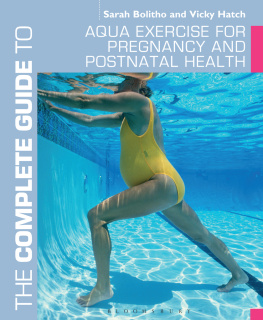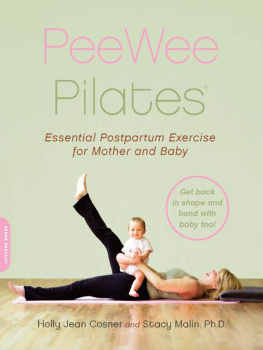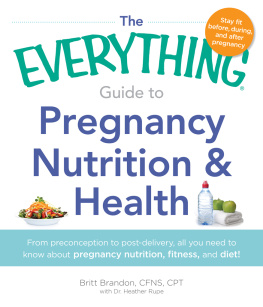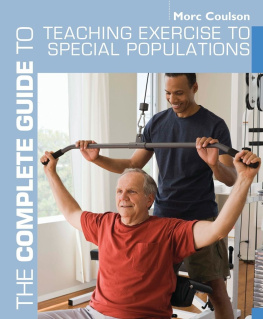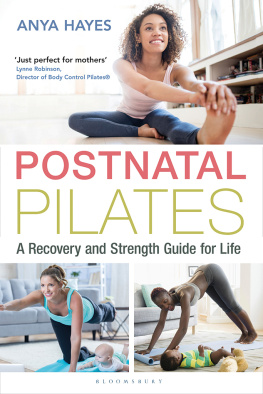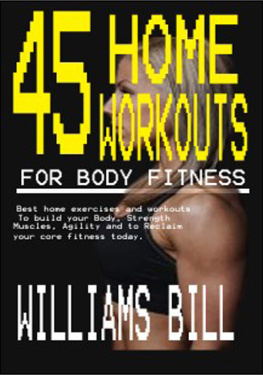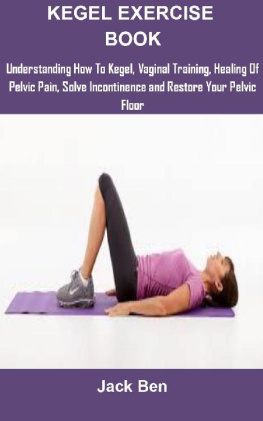This book is dedicated to the memory of
my wonderful dad Ted Moyes:
may his spirit live forever!
CONTENTS
It takes nine months for a woman to develop and nurture a new life and her body must undergo many complex and amazing changes. So why is it that the minute baby is born, women are expected to get their pre-pregnancy shape back and be a supermum?
Much of the pressure is put on women by themselves but if media images were more realistic perhaps women would give themselves and their bodies longer to recover. Women should be encouraged to respect their post-baby bodies for the wonderful gift of life and celebrate motherhood but that doesnt mean becoming a couch potato!
Instructors have a responsibility to save women from themselves by guiding and advising them how to do this sensibly and safely. Rushing back to exercise and participating in unsuitable activities will increase the risk of long-term physical problems. Return to fitness and regular weight should be viewed as a long-term goal for health-related fitness.
The fact that you are reading this suggests you are interested in providing the correct advice but what about instructors who dont know or dont have the inclination to find out? The inclusion of postnatal women in mainstream classes is a regular occurrence and instructors teaching in such settings have a responsibility to provide safe alternatives, rather than just advising women to take it easy. Unconscious incompetence is very dangerous!
It isnt just a matter of her starting where she left off and resuming her pre-pregnancy training programme; major changes have occurred in the structural support systems of a postnatal woman and her body continues to be vulnerable, particularly if breastfeeding. A postnatal programme should focus on the journey back to the pre-pregnancy body with particular consideration for poor lumbopelvic stability, reduced joint stability and postural changes. Re-education of incorrect muscle patterns and correction of muscle imbalances should be addressed before fitness can be progressed and spending time dealing with these issues should be the first priority. Women also need guidelines for managing their bodies in everyday activities and instructors should incorporate this advice into their teaching as much as possible.
Women should not commence formal exercise until they have completed a satisfactory postnatal check-up, which is normally conducted around six weeks after delivery; those who had caesarean deliveries are recommended to wait a couple of weeks longer.
ABOUT THE GUIDE
The Complete Guide to Postnatal Fitness was written in response to the demand for more detailed information on the subject from group fitness instructors and personal trainers.
This third edition has been completely revised and updated and is presented at a higher level than the previous two. It is full of the latest research available, with all references cited for further reading if desired. Some topics lack scientific evidence and this has been discussed where relevant. In such cases, the recommendations have been based on a sound knowledge of the anatomical and physiological implications of pregnancy and delivery, together with more than 22 years experience of teaching postnatal fitness.
As always, the minute a book goes to print new research is released so the onus must be on the instructor to stay up to date through further reading and training. Science never stands still keep learning and exploring this field of fitness as there is always more to learn!
HOW TO USE THE GUIDE
Whilst it is hoped you will read the guide from cover to cover, it is also intended as an essential resource for you to dip in and out of as required. With this in mind, the chapters are all self-contained and cross-referenced as necessary.
look at the anatomical and physiological implications of pregnancy and delivery, how these will affect the return to exercise in the postnatal period, and how exercise can help the body to recover quicker. It is vital that these chapters are read and fully understood before teaching postnatal women, and referral back to them is recommended from time to time.
are all about exercise. They look at cardiovascular and resistance training methods and a range of specific fitness sessions in terms of their suitability during the postnatal period. They also contain a fully detailed programme of appropriate postnatal exercises.
are concerned with planning, management, teaching and evaluation of a specific postnatal exercise session and the strategies involved in its success.
For ease of writing the early postnatal period is defined as birth to six weeks and the extended postnatal period is anything after that time.
BENEFITS OF POSTNATAL EXERCISE
Posture
Improved lumbopelvic stability
Correction of pregnancy stance
Strengthening muscles that have lengthened
Lengthening muscles that have shortened
Redressing muscular imbalance
Awareness of posture while feeding/lifting/carrying
Awareness of back, abdominal and pelvic care
Functional capacity
Improved lumbopelvic stability
Increased strength and endurance for activities of daily living
Improved aerobic fitness
Increased ability to deal with the everyday demands of a new baby
Reduced fatigue increased energy
General health
Boosted immune system
Improved sleep quality
Improved circulation and healing
Improved digestion
Body composition
Increased muscle mass
Increased metabolic rate
Increased calorific burning
Increased fat loss
Social and emotional well-being
Increased production of endorphins
Enhanced self-image and self-confidence
Personal satisfaction and achievement
Personal identification
Increased social interaction
RISKS OF POSTNATAL EXERCISE
Fatigue and exhaustion
Injury from reduced joint stability
Injury from poor lumbopelvic stability
Injury from inappropriate exercises or technique
Contraindications to exercise
Joint or pelvic girdle pain
Inadequate healing, discomfort
Excessive fatigue
Gross separation of rectus abdominis
THE PELVIS
Structure of the pelvis
The pelvis is made up of four bones: two hip bones, plus the sacrum and the coccyx. Each hip bone is made up of three fused bones: ilium, ischium and pubis. The acetabulum, the deep socket for the head of the femur, is formed by the unification of all three bones.
The ilium is the large wing-shaped part of the pelvis providing a broad surface area for muscle attachment. The upper border, the iliac crest, can be felt when the hands are placed on the hips. The bony points at each end of the iliac crest can be felt at the front of the pelvis, as the anterior superior iliac spines (ASIS), and at the back, as the posterior superior iliac spines (PSIS). These are useful landmarks when checking correct postural alignment as they should be approximately at the same level.
The ischium is the thick, lower part of the pelvis leading down to the ischial tuberosities, commonly referred to as the sit bones.
The pubis is at the front of the pelvis where the two pubic bones join to form the symphysis pubis at the top and the pubic arch underneath.
The sacrum is a triangular-shaped bone made up of five fused vertebrae. It is joined to the ilium by the sacroiliac joints, which are positioned on either side of the sacrum.


